
The Hellenic Air Force is the air force of Greece. It is considered to be one of the largest air forces in NATO, and is globally placed 18th out of 139 countries. Under the Kingdom of Greece from 1935 to 1973, it was previously known as the Royal Hellenic Air Force (RHAF).
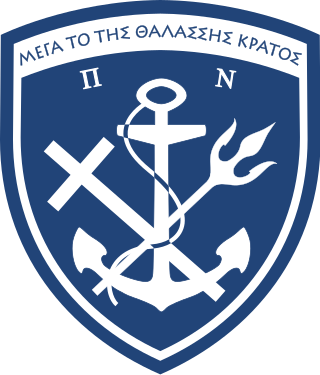
The Hellenic Navy is the naval force of Greece, part of the Hellenic Armed Forces. The modern Greek navy historically hails from the naval forces of various Aegean Islands, which fought in the Greek War of Independence. During the periods of monarchy it was known as the Royal Hellenic Navy.
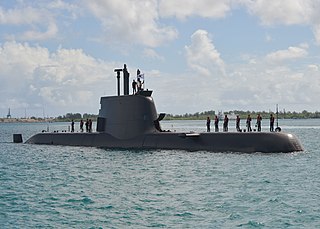
The Type 214 is a class of diesel–electric submarines developed exclusively for export by Howaldtswerke-Deutsche Werft GmbH (HDW). It features diesel propulsion with an air-independent propulsion (AIP) system using Siemens polymer electrolyte membrane (PEM) hydrogen fuel cells. The class combines the design principles of the Type 209 submarine family and the features of the Type 212A submarine. However, as an export design, it lacks some of the classified technologies of the Type 212 such as the non-magnetic steel hull that makes it difficult to detect using a magnetic anomaly detector.

The Elli-class frigates are a series of frigates operated by the Hellenic Navy. The ships are of Dutch origin and are also known as Kortenaer-class or Standard-class or S-class frigates. The first two ships, which have lengthened hangars and different armament were built specifically for the Hellenic Navy. The remaining ships are ex-Royal Netherlands Navy S-frigates of the Kortenaer class transferred to the Hellenic Navy in the 1990s and early 2000s. These robust and reliable ships constitute the backbone of the Hellenic Navy. Elli, for which the class is named, is itself named after two famous Greek cruisers, one of which was sunk during peacetime before the Greco-Italian War.

HNLMS Jan van Brakel (F825) was a frigate of the Kortenaer class in service with the Royal Netherlands Navy from 1983-2001. She was renamed HS Kanaris (F464) upon transfer to the Hellenic Navy in 2002.
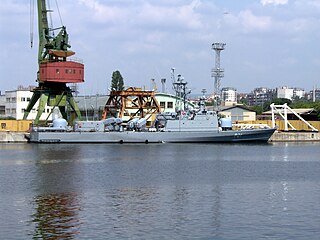
The La Combattante III type missile boats are two classes of fast attack craft built for the Hellenic Navy. The first group of four were ordered by Greece in September 1974 from France. The vessels had no class name but are referred to by type. They are similar to the La Combattante IIa-class fast attack craft already in service, but are larger and armed with torpedoes. A second group of six were ordered in 1978, to be built under license in Greece and use the Norwegian Penguin Mk 2 Mod 3 missiles. Since 2019, all the ships of the class use Harpoon anti-ship missiles.

The Zubr class, Soviet designation Project 1232.2, is a class of Soviet-designed air-cushioned landing craft (LCAC). The name "Zubr" is Russian for the European bison. This class of military hovercraft is, as of 2023 the world's largest hovercraft, with a standard full load displacement of 555 tons. The hovercraft was designed to sealift amphibious assault units from equipped/non-equipped vessels to non-equipped shores, as well as to transport and plant naval mines.

The Jason-class tank landing ship is a class of tank landing ships (LSTs) designed and built in Greece through a cooperation of the Elefsis Shipyards with the National Technical University of Athens and the Hellenic Navy, which ordered the ships in 1986. Along with the Zubr-class LCAC, they are the primary amphibious warfare ships of the Hellenic Navy. The first was laid down on 18 April 1987, second in September 1987, third in May 1988, fourth in April 1989 and fifth in November 1989. Completion of all five and in particular the last three was severely delayed by the shipyard's financial problems, which was privatised in October 1997. Greece tried to start building a sixth ship in 2000 but cancelled it before construction began.

Hydra (F-452) is the lead ship of the Greek Hydra-class frigate and flagship of the Hellenic Navy. The ship was built in the same shipyard as the Blohm + Voss MEKO 200 frigate class, on which its design was based. Three more vessels were built by Hellenic Shipyards Co. at Skaramagas in following years. It is the fifth ship in the Hellenic Navy to bear the name Hydra.

The Roussen class is a seven-strong class of British-designed fast attack missile boats improved and customized for the Hellenic Navy, also known as Super Vita. The class is named after its lead ship, which in turn is named after Lt Nikolaos Roussen, a World War II submarines officer who was killed in the suppression of the Navy mutiny in April 1944.

The Harpoon is an all-weather, over-the-horizon, anti-ship missile manufactured by McDonnell Douglas. The AGM-84E Standoff Land Attack Missile (SLAM) and later AGM-84H/K SLAM-ER are cruise missile variants.
The Naval Air Service was the air arm of the Hellenic Navy from 1915 to 1930.
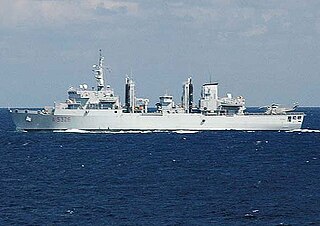
Etna is an auxiliary ship that entered service with the Marina Militare in 1998. She is designed to support fleet operations with fuel and dry stores. Etna is the single Italian vessel of the Etna class while a sister ship, HS Prometheus, was built under licence in Greece and entered service with the Hellenic Navy in 2003.

The Etna class is a ship class of two naval replenishment and logistic support ships used by the Italian Navy and by the Greek Navy The two ships are almost identical but they have differences in their armament and sensor equipment.

The Frégate de Défense et d'Intervention or FDI, formerly denominated Frégate de Taille Intermédiaire or FTI, is a programme launched in 2015 to produce a new class of first-rank French frigates to complement the Aquitaine-class. As of February 2022, five ships have been ordered for the French Navy and will form the Amiral Ronarc'h class, with the lead ship expected to be commissioned in 2025. In 2021, three units were ordered by Greece for the Hellenic Navy and will form the Kimon-class.

The Ouranos class is a ship class of two coastal tankers used by the Hellenic Navy. The ships are almost identical in size. They were built in 1975–1977 and they were commissioned into the Hellenic Navy in 1977. Their main task is to supply other ships and naval bases of the Hellenic Navy with fuel and drinking water.

HNLMS Kortenaer (F807) was a frigate of the Kortenaer class. The ship was in service with the Royal Netherlands Navy from 1978-97 and today serves as HS Kountouriotis with the Hellenic Navy. The frigate was initially named after Dutch naval hero Egbert Bartholomeusz Kortenaer and then after Pavlos Kountouriotis, distinguished Admiral of the Hellenic Navy, responsible for Greek naval victories in the Aegean Sea that secured the Aegean for Greece during the First Balkan War. The ship's radio call sign was "PADA".
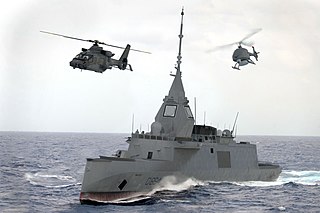
The Kimon class, also known as the FDI HN, is a frigate class for the Hellenic Navy. The FDI HN is a more heavily armed version of the French frigates. The lead ship is expected to be commissioned in early 2025.
















